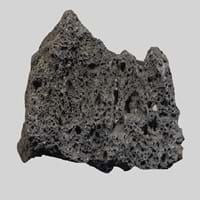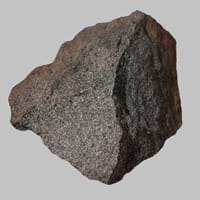Definition
Scoria is a dark-colored extrusive igneous rock with abundant round bubble-like cavities
Foidolite is a rare type of coarse-grained intrusive igneous rock with a feldspathoid mineral content greater than 60%
Discoverer
Unknown
Unknown
Etymology
From late Middle English (denoting slag from molten metal), from Greek skōria refuse, from skōr dung
From the mineral feldspathoid which is the main content of rock
Class
Igneous Rocks
Igneous Rocks
Sub-Class
Durable Rock, Medium Hardness Rock
Durable Rock, Soft Rock
Other Categories
Fine Grained Rock, Opaque Rock
Coarse Grained Rock, Fine Grained Rock, Medium Grained Rock, Opaque Rock
Color
Black, Brown, Dark Grey to Black, Red
Black, Brown, Colourless, Green, Grey, Pink, White
Durability
Durable
Durable
Appearance
Glassy and Vesicular
Dull
Interior Uses
Decorative Aggregates, Interior Decoration
Decorative Aggregates, Interior Decoration
Exterior Uses
Garden Decoration, Paving Stone
As Building Stone, As Facing Stone, Garden Decoration, Paving Stone
Other Architectural Uses
Curbing
Curbing
Construction Industry
Cement Manufacture, Construction Aggregate, for Road Aggregate, In landscaping and drainage works
As Dimension Stone, Cement Manufacture, for Road Aggregate
Medical Industry
Not Yet Used
Taken as a Supplement for Calcium or Magnesium
Antiquity Uses
Artifacts, Monuments, Sculpture
Artifacts, Monuments, Sculpture
Commercial Uses
As a traction material on snow-covered roads, Creating Artwork, High-temperature insulation, In gas barbecue grills
Cemetery Markers, Commemorative Tablets, Creating Artwork
Types
Not Available
Not Available
Features
Available in Lots of Colors and Patterns, Generally rough to touch, Surfaces are often shiny
Host Rock for Lead
Archaeological Significance
Famous Monuments
Data Not Available
Data Not Available
Famous Sculptures
Data Not Available
Data Not Available
Formation
Scoria forms when magma containing huge amount of dissolved gas flows from a volcano during an eruption.
Foidolites is a fine-grained, hard rock which is a type of metasomatite, essentially altered basalt. It forms with or without crystallization, either below the surface as intrusive rocks or on the surface as extrusive rocks.
Mineral Content
Apatite, Biotite, Calcite, Feldspar, Hematite, Hornblade, Ilmenite, Magnetite, Olivine, Pyroxene, Quartz, Silica
Amphibole, Biotite, Feldspar, Olivine, Plagioclase, Pyroxene
Compound Content
Ca, NaCl
Aluminium Oxide, CaO, Iron(III) Oxide, FeO
Types of Metamorphism
Burial Metamorphism, Cataclastic Metamorphism, Contact Metamorphism
Burial Metamorphism, Cataclastic Metamorphism, Hydrothermal Metamorphism, Impact Metamorphism
Types of Weathering
Biological Weathering, Chemical Weathering, Mechanical Weathering
Not Applicable
Types of Erosion
Chemical Erosion, Coastal Erosion, Glacier Erosion
Not Applicable
Grain Size
Fine Grained
Medium to Fine Coarse Grained
Fracture
Conchoidal
Conchoidal
Porosity
Highly Porous
Very Less Porous
Luster
Subvitreous to Dull
Subvitreous to Dull
Toughness
2.1
Not Available
Specific Gravity
Not Available
2.86
Transparency
Opaque
Translucent
Density
Not Available
Not Available
Resistance
Heat Resistant, Impact Resistant, Pressure Resistant, Wear Resistant
Heat Resistant, Wear Resistant
Deposits in Eastern Continents
Asia
Afghanistan, Indonesia, Japan, Russia
Russia
Africa
Ethiopia, Kenya, Tanzania
South Africa, Western Africa
Europe
Greece, Hungary, Iceland, Italy, Turkey
Not Yet Found
Others
Not Yet Found
Not Yet Found
Deposits in Western Continents
North America
Bahamas, Barbados, Canada, Costa Rica, Cuba, Jamaica, Mexico, USA
Canada, USA
South America
Argentina, Chile, Ecuador, Peru
Not Yet Found
Deposits in Oceania Continent
Australia
New Zealand, Western Australia
Central Australia, Western Australia
All about Scoria and Foidolite Properties
Know all about Scoria and Foidolite properties here. All properties of rocks are important as they define the type of rock and its application. Scoria and Foidolite belong to Igneous Rocks.Texture of Scoria is Vesicular whereas that of Foidolite is Earthy. Scoria appears Glassy and Vesicular and Foidolite appears Dull. The luster of Scoria and Foidolite is subvitreous to dull. Scoria is available in black, brown, dark grey to black, red colors whereas Foidolite is available in black, brown, colourless, green, grey, pink, white colors. The commercial uses of Scoria are as a traction material on snow-covered roads, creating artwork, high-temperature insulation, in gas barbecue grills and that of Foidolite are cemetery markers, commemorative tablets, creating artwork.










